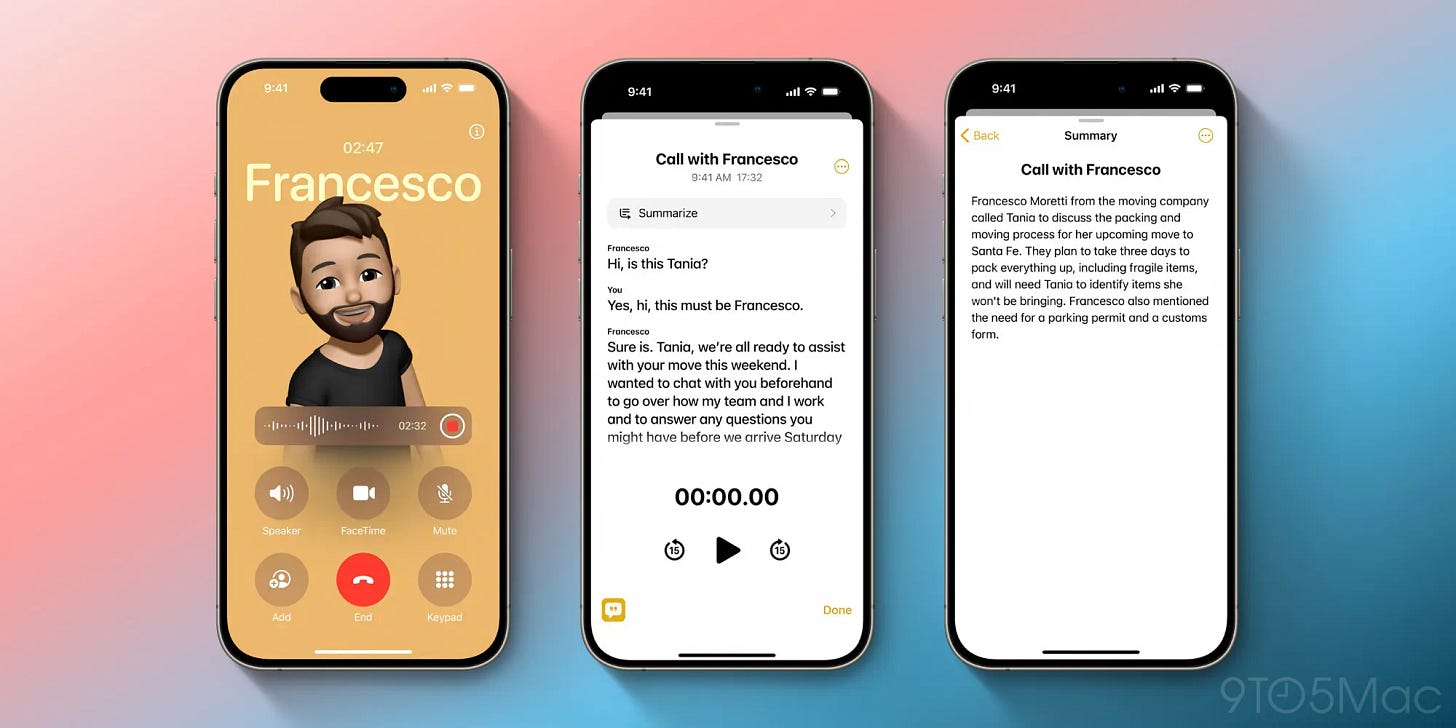Apple Intelligence Revisited: The iPhone 16 Brings AI Vision into Focus
We now have a clearer picture of how Apple's vision for AI is taking shape in tangible, user-facing features.
When Apple first unveiled its AI strategy with Apple Intelligence earlier this year, we caught a glimpse of the company's ambitious plans. Now, with the iPhone 16's official announcement, we have a clearer picture of how this vision is taking shape in tangible, user-facing features. Let's delve into the evolving landscape of Apple's AI integration and what it means for the future of mobile technology.
Apple's announcement of Apple Intelligence at WWDC 2024 marked a significant milestone in the artificial intelligence revolution. This move addressed growing concerns about Apple's position in the rapidly evolving AI landscape. Now, with the recent iPhone 16 event, we've gained a clearer picture of how Apple Intelligence is being integrated throughout the company's ecosystem.
The iPhone 16 announcement showcased practical applications of Apple Intelligence across various devices and services. From enhanced translation capabilities on the Apple Watch Series 10 to advanced visual search on iPhones, these demonstrations illustrate Apple's commitment to weaving AI seamlessly into its product lineup. This approach not only responds to industry trends but also sets a new standard for AI integration in consumer technology.
Apple's Unique Approach to AI
Apple Intelligence represents a departure from the standalone AI platforms popularized by competitors. Instead of creating a separate AI entity, Apple has opted for a deeply integrated approach, weaving AI capabilities into the fabric of its existing software and services. This strategy aligns with Apple's "AI for the rest of us" philosophy, emphasizing practical, user-centric applications of AI technology. By enhancing familiar apps and services with AI, Apple aims to make advanced technology accessible and beneficial to everyday users without overwhelming them with new interfaces or concepts.
Key Features of Apple Intelligence:
Writing Tools: Apple Intelligence introduces AI-powered writing assistance across various applications, including Mail, Messages, and Pages. These tools offer functionalities such as text summarization, proofreading, and AI-generated writing based on user prompts. The integration aims to streamline communication and content creation within the Apple ecosystem.
Image Generation: Apple's foray into AI-generated imagery includes two notable features. Genmojis allows users to create custom emojis using AI, adhering to Apple's distinctive design aesthetic. Image Playground, a standalone app, enables users to generate images based on text prompts. These visual AI tools integrate seamlessly with other Apple applications, facilitating creative expression in messaging and presentations.
Siri: Apple Intelligence significantly enhances Siri's capabilities, addressing long-standing criticisms of the digital assistant. The new Siri boasts improved contextual awareness, allowing it to operate across multiple apps simultaneously. This cross-app functionality enables more complex tasks, such as editing a photo and inserting it into a message through voice commands.
Visual indicators replace the traditional Siri icon, with a glowing light around the iPhone's edge signaling Siri's activity. This design change reflects a more ambient and integrated AI presence in the user interface.
The enhanced Siri also leverages on-screen awareness to provide more relevant and context-appropriate responses. This advancement aims to create a more intuitive and frictionless user experience, bridging the gap between voice commands and on-screen content.
The Technology Behind Apple Intelligence
Apple Intelligence employs a small-model, bespoke approach to AI training, distinguishing itself from the large, generalized models used by many competitors. This strategy involves compiling specific datasets in-house for targeted tasks, such as email composition or image generation.
The primary advantage of this approach is efficiency. Many AI functions can be performed on-device, reducing reliance on cloud computing and enhancing privacy. This aligns with Apple's long-standing commitment to user data protection and on-device processing.
For more complex queries that exceed local processing capabilities, Apple has introduced Private Cloud Compute. This system utilizes remote servers running on Apple Silicon, purportedly offering the same level of privacy as Apple's consumer devices. The transition between on-device and cloud processing is designed to be seamless, with users experiencing interruptions only when offline.
Rollout Strategy and Accessibility
Apple Intelligence's rollout is carefully phased to ensure stability and gather user feedback. The initial beta launch is scheduled for October 2024 in the United States, supporting only English language interactions. This cautious approach allows Apple to refine the system before wider deployment.
The international rollout will proceed gradually. December 2024 will see the introduction of localized English support in several countries, including Australia, Canada, and the UK. Further language expansion, including Chinese, French, Japanese, and Spanish, is planned for 2025.
Hardware requirements for Apple Intelligence are notably stringent, reflecting the sophisticated nature of the technology. The system will be compatible with:
iPhone 15 Pro and Pro Max (A17 Pro chip)
iPad Pro and Air (M1 chip and later)
MacBook Air, Pro, iMac, Mac mini, Mac Studio, and Mac Pro (M1 chip and later)
These requirements suggest that Apple Intelligence leverages advanced hardware capabilities, potentially limiting its accessibility to users with older devices.
Apple's AI Ecosystem and Partnerships
While Apple Intelligence represents a significant in-house AI development, Apple recognizes the value of external partnerships in expanding its AI capabilities. The company's collaboration with OpenAI is particularly noteworthy.
This partnership appears to be less about powering core Apple Intelligence features and more about offering complementary capabilities. It suggests an acknowledgment from Apple that its small-model approach, while efficient, may have limitations for certain advanced AI tasks.
Apple Intelligence will be free to use, as will basic access to integrated OpenAI services. However, users with paid OpenAI accounts will have access to premium features, potentially driving subscriptions to the third-party AI platform.
Apple has indicated plans to partner with additional AI services, with Google's Gemini likely to be among the next collaborations. This open approach to partnerships suggests that Apple views its role not just as an AI developer, but as an integrator of diverse AI capabilities within its ecosystem.
These partnerships could significantly expand the range of AI functionalities available to Apple users, while still maintaining the seamless, privacy-focused experience that Apple prioritizes. It also positions Apple as a potential gatekeeper for AI services on its platforms, a role that could have significant implications for the broader AI industry.
Apple Intelligence and the Mobile Experience
Apple Intelligence marks a significant shift in how AI integrates into the mobile experience, starting with the iPhone 15 Pro and extending to future models. This approach doesn't just add AI as a separate feature but weaves it throughout the core functionalities of iOS devices.
Visual Intelligence exemplifies this integration, elevating the camera system from a simple image capture tool to an AI-powered information hub. By leveraging Apple Intelligence, the upcoming iPhone 16 will interpret visual data in real-time, allowing users to interact with their environment in novel ways. Capturing a storefront image can instantly provide business information, or photographing a poster can automatically create a calendar event. This demonstrates how AI enhances existing features to create more intuitive and powerful user experiences across Apple's mobile devices.
The evolution of Siri further illustrates Apple's AI integration strategy. The shift to a subtle rainbow ring interface signals a move towards ambient AI, always present but unobtrusive. This new Siri leverages Apple Intelligence to improve natural language processing, enabling more complex, context-aware interactions across multiple apps simultaneously. The introduction of "Private Cloud Compute" for advanced queries showcases Apple's commitment to balancing powerful AI capabilities with user privacy across its mobile ecosystem.
Apple Intelligence significantly enhances photography capabilities on iOS devices, not through hardware improvements, but through smart, AI-driven features. The "Clean Up" function, advanced photo search, and AI-generated video memories demonstrate how intelligence can breathe new life into existing photo libraries and elevate the photography experience for all compatible iPhones.
Productivity tools also benefit from Apple Intelligence integration. AI-powered transcription for phone calls and voice recordings, along with intelligent writing assistance, show how Apple is using AI to streamline everyday tasks, making iPhones even more indispensable tools for communication and work.
By positioning compatible iPhones as evolving AI platforms rather than static hardware products, Apple is redefining the concept of a smartphone. The promise of continuous AI-driven improvements through software updates extends devices' relevance beyond traditional upgrade cycles, potentially transforming how consumers perceive and interact with their mobile devices. This approach ensures that Apple Intelligence will play a central role in shaping the future of the iPhone experience, regardless of the specific model or generation. It is a clear step towards the vision of transforming Apple’s platform into a set of interconnected intelligent agents that anticipate user needs, seamlessly integrate across devices, and provide personalized experiences powered by AI and machine learning.
The Bottom Line
Apple Intelligence marks a pivotal moment in the evolution of consumer AI technology. By integrating AI capabilities seamlessly into its ecosystem, particularly with the iPhones, Apple is not just responding to industry trends but actively shaping the future of mobile computing. The company's measured rollout strategy, emphasis on privacy, and openness to strategic partnerships demonstrate a thoughtful approach to AI integration.
As these features continue to evolve and expand, they promise to transform user interactions with Apple devices, potentially redefining the smartphone experience and setting new standards for AI in consumer technology. The true impact of Apple Intelligence will unfold in the coming months and years, as users adapt to and explore these new capabilities, ultimately determining the success of Apple's vision for AI in our daily digital lives.
Keep a lookout for the next edition of AI Uncovered!
Follow on Twitter, LinkedIn, and Instagram for more AI-related content.






